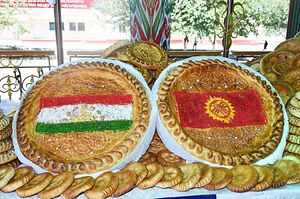On July 25, the only road linking residents of Vorukh, a Tajik enclave in Kyrgyzstan’s southernmost province, to the rest of Tajikistan opened after a three-day blockage. The road had been blocked unlawfully following a flare-up of violence on July 22. Two days of fighting left a man dead, 30 people injured, and several hundred villagers evacuated.
The next afternoon, Presidents Sooronbay Jeenbekov and Emomali Rahmon met to discuss the process of border demarcation in Isfara, a town in northern Tajikistan not far from the Vorukh enclave. The meeting was not in response to the border violence – and in fact, some have even suggested that the presidents’ trip to Isfara contributed to cross-border tension as villagers hung flags in anticipation of their leaders’ visit – but the fighting certainly underscored the importance of settling any uncertainty about where the border between Kyrgyzstan and Tajikistan should lay.
Even though almost 30 years have passed since both countries gained independence, disagreement about the exact location of borders remains a pressing problem. Of the 971 kilometers that make up the border between Kyrgyzstan and Tajikistan, as of 2017, 471 kilometers remain undefined. Although more than 70 pieces of territory are contested along the Kyrgyz-Tajik border, Vorukh – specifically, whether it is actually an enclave – has consistently been at the forefront of discussions about border demarcation.
One challenge with deciding where the border should rest is that historical maps can serve as supporting evidence for either side’s claim.
Tajik authorities rely on maps from the 1924-27 period as a reference point; Kyrgyz officials are using maps from 1958-59 in bilateral negotiations. Geographer Markus Hauser explored the chronology of Vorukh’s borders and found that Soviet maps made before 1941 show the disputed Vorukh enclave as part of the Tajik SSR, but by 1948, Vorukh suddenly appears as an exclave on a map of the Kyrgyz SSR.
A cynical explanation for this inconsistency is that Soviet authorities specifically designed the geography of the Ferghana Valley – and fiddled with boundaries over time – to sow instability. However, this is an intellectually lazy trope that overdetermines the importance of top-down processes and strips Central Asians of agency, as historian Alexander Morrison argued in a February 2017 article for Eurasianet. In emphasizing the inevitability of conflict, the “Stalin’s pencil” or “divide and rule” argument overlooks the possibility for local populations to endure and adapt to uncertainty around the border.
Anthropologist Madeleine Reeves has written extensively about the ingenuity and resilience that characterizes border communities in the Ferghana Valley. In a 2014 article written for Eurasianet, she identified trade as the “cornerstone of interethnic and cross-border peace.” International trade in the Ferghana Valley has relied on central governments remaining distant; in the article, she describes a school director who proudly recalled the time their community rallied against a border control post in the village that would have disrupted trade routes and the routine of everyday life.
Intervention by national governments and international actors can disrupt the delicate balance of social and economic life on the border. Although many initiatives are well-intentioned, some infrastructure projects or policies meant to enhance security end up intensifying local tensions. For example, a road built in 2008 with World Bank support that bypassed Tajik enclaves to link Kyrgyz villages with the nearest regional capital was supposed to give locals a sense of connectivity. Instead, it made Vorukh’s Tajik community feel cut off; in this way, Reeves said that the road served to “separate as well as connect.”
The Janus-faced nature of government intervention – projects that simultaneously separate and connect, enhance security, and exacerbate threats – extends into citizens’ expectations from the state. While Reeves’ work has shown some instances when Ferghana Valley communities have preferred the government to stay out of local affairs, Kyrgyz political scientist Emil Dzhuraev recently argued in local outlet El-Gezit that Bishkek and Dushanbe have erred in consistently ignoring their distant border regions; citizens there are resentful about having been left to fend for themselves. Both attitudes can hold true at the same time, and successfully navigating this tension is crucial for creating conditions for long-term peace.
It’s easy to hold up border demarcation as the light at the end of the tunnel, a magical solution that will end interethnic and cross-border violence in the Ferghana Valley. But as Dzhuraev pointed out in his July 24 piece for El-Gezit, the stakes will only increase once the border is decided. Questions about water, roads, and pasture – shared resources that do not necessarily respect political geography – will continue to demand attention.
Kyrgyzstan and Tajikistan’s recent renewed interest in border delimitation suggests that the governments want to dedicate more attention and resources to the communities living in the Ferghana Valley. But it is not enough to host photo-worthy meetings where politicians just promise to solve problems that have festered for decades.
































